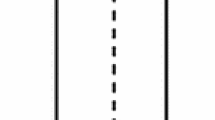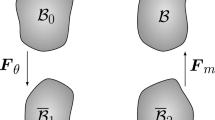Abstract
Chemo-mechanical coupling exists in a lot of intelligent materials including hydrogels, biological tissues and other soft materials. These materials are able to respond to external stimulus, such as temperature, chemical concentration, and pH value. In this paper, a one-dimensional theoretical model for chemo-mechanical coupling is proposed for analyzing the uniaxial stress/strain state of coupling materials. Based on the chemo-mechanical coupled governing equation, the displacement function and concentration function are derived and the stress and chemical potential are obtained. It is shown that the present chemo-mechanical theory can characterize the chemo-mechanical coupling behavior of intelligent materials.
Similar content being viewed by others
References
Yang, H.H., Liu, H.P. and Tan, W.H., Engineering target-responsive hydrogels based on aptamer-target interactions. Journal of the American Chemical Society, 2008, 130: 6320–6321.
Loret, B., Gajo, A. and Simoes, M.F.F. A note on the dissipation due to generalized diffusion with electro-chemo-mechanical couplings in heteroionic clays. European Journal of Mechanics A/Solids, 2004, 23: 763–782.
Moyne, C. and Murad, M.A., A two-scale model for coupled electro-chemo-mechanical phenomena and on-sager’s reciprocity relations in expansive clays: I homogenization analysis. Transport in Porous Media, 2006, 62: 333–380.
Alessandro, G. and Loret, B., Finite element simulations of chemo-mechanical coupling in elastic-plastic homoionic expansive clays. Computer Methods in Applied Mechanics and Engineering, 2003, 192: 3489–3530.
Stora, E., Bary, B., He, Q.C., Deville, E. and Montarnal, P., Modeling and simulations of the chemo-mechanical behaviour of leached cement-based materials. Cement and Concrete Research, 2009, 39: 763–772.
Yang, Q.S. and Li, C.J., Evolution of properties in hydration of cements–a numerical study. Mechanics Research Communications, 2006, 33(5): 717–727.
Poulet, T., Regenauer-Lieb, K. and Karrech, A., A unified multi-scale thermodynamical framework for coupling geomechanical and chemical simulations. Tectonophysics, 2010, 483: 178–189.
Gu, W.Y., Lai, W.M. and Mow, V.C., A triphasic analysis of negative osmotic flows through charged hydrated soft tissues. Biomechanics, 2007, 30: 71–78.
Leveston, M.E., Frank, E.H. and Grodzinsky, A.J., Variationally derived 3-field finite element formulations for quasistatic poroelastic analysis of hydratesd biological tissues. Computer Methods in Applied Mechanics and Engineering, 1998, 156: 231–246.
Loret, B. and Simoes, F.M.F., A framework for deformation, generalized diffusion, mass transfer and growth in multi-species multi-phase biological tissues. European Journal of Mechanics A/Solids, 2005, 24: 757–781.
Loret, B. and Simoes, F.M.F., Articular cartilage with intra- and extrafibrillar waters: a chemo-mechanical model. Mechanics of Materials, 2004, 36: 515–541.
Sundaresan, V.B. and Leo, D.J., Chemo-mechanical model of biological membranes for actuation mechanisms. Smart Materials and Structures, 2005, 5761: 108–118.
Loix, F., Simoes, F.M.F. and Loret, B., Articular cartilage with intra and extrafibrillar waters–simulations of mechanical and chemical loadings by the finite element method. Computer Methods in Applied Mechanics and Engineering, 2008, 197: 4840–4857.
Ballhause, D. and Thomas, W., Coupled chemo-electro-mechanical finite element simulation of hydrogels: I. chemical stimulation. Smart Materials and Structures, 2008, 17: 1–10.
Valleton, J.M., Grodzinsky, A.J. and Selegny, E., Theoretical study of mechano-chemical couplings in a compartmental enzyme system : analytical treatment. Biophysical Chemistry, 1987, 26: 29–38.
Doi, M., Matsumoto, M. and Hirose, Y., Deformation of ionic polymer gels by electric fields. Macromolecules, 1992, 25: 5504–5511.
Thomas, W., Bernd, K. and Rainer, W.G., Coupled chemo-electro-mechanical formulation for ionic polymer gels numerical and experimental investigations. Mechanics of Materials, 2004, 36: 411–420.
Lu, N.S., Suo, Z.G. and Vlassak, J.J., The effect of film thickness on the failure strain of polymer-supported metal films. Acta Materialia, 2010, 58: 1679–1687.
Yashin, V.V., Kuksenok, O. and Balazs, A.C., Modeling autonomously oscillating chemo-responsive gels. Progress in Polymer Science, 2010, 35: 155–173.
Loeffel, K. and Anand, L., A chemo-thermo-mechanically coupled theory for elastic-viscoplastic deformation, diffusion, and volumetric swelling due to a chemical reaction. International Journal of Plasticity, 2011, 27: 1409–1431.
Li, H., Luo, R. and Birgersson, E., Modeling of multiphase smart hydrogels responding to PH and electric voltage coupled stimuli. Journal of Appied Physics, 2007, 101: 114905.
Kaasschieter, E.F., Frijns, A.J.H. and Huyghe, J.M., Mixed finite element modeling of cartilaginous tissues. Mathematics and Computers in Simulation, 2003, 61: 549–560.
Hong, W., Liu, Z.S. and Suo, Z.G., Inhomogeneous swelling of a gel in equilibrium with a solvent and mechanical load. International Journal of Solids and Structures, 2009, 46: 3282–3289.
Marcombe, R., Cai, S.Q., Hong, W., Zhao, X.H., Lapusta, Y. and Suo, Z.G., A theory of constrained swelling of a pH-sensitive hydrogel. Soft Matter, 2010, 6: 784–793.
Yang, Q.S., Liu, B.S. and Meng, L.T., A phenomenological theory and numerical procedure for chemo-mechanical coupling behavior of hydrogel. CMC-Computers Materials and Continua, 2009, 12: 39–55.
Yang, Q.S., Qin, Q.H., Lu, X.Z. and Cui, C.Q., A theoretical model and finite element formulation for coupled thermo-electro-chemo-mechanical media. Mechanics of Materials, 2010, 42: 148–156.
De, S.K., Aluru, N.R. and Johnson, B., Equilibrium swelling and kinetics of pH-responsive hydrogels: models, experiments, and simulations. Journal of Microelectromechanical Systems, 2002, 11: 544–555.
Li, H., Luo, R. and Birgersson, E., A chemo-electro-mechanical model for simulation of responsive deformation of glucose-sensitive hydrogels with the effect of enzyme catalysis. Journal of Mechanics and Physics of Solids, 2009, 57: 369–382.
Li, H., Lai, F. and Luo, R., Analysis of responsive characteristics of ionic-strength-sensitive hydrogel with consideration of effect of equilibrium constant by a chemo-electro-mechanical model. Langmuir, 2009, 2: 13142–13150.
Lai, F., Li, H. and Luo, R., Chemo-electro-mechanical modeling of ionic-strength-sensitive hydrogel: influence of Young’s modulus. Internatinal Journal of Solids and Structures, 2010, 47: 3141–3149.
Giovanni, D.B., Luca, P. and Maurizio, P., A mixture theory framework for modeling the mechanical actuation of ionic polymer metal composites. Smart Materials and Structures, 2008, 17: 045010.
Author information
Authors and Affiliations
Corresponding author
Additional information
The project supported by the National Natural Science Foundation of China (Nos. 10872011 and 11172012) and the Municipal Natural Science Foundation of Beijing (No. 3092006).
Rights and permissions
About this article
Cite this article
Yang, Q., Tian, H. & Qin, Q. Analytical Solutions for a One-Dimensional Chemo-Mechanical Coupling Problem. Acta Mech. Solida Sin. 27, 137–145 (2014). https://doi.org/10.1016/S0894-9166(14)60024-0
Received:
Revised:
Published:
Issue Date:
DOI: https://doi.org/10.1016/S0894-9166(14)60024-0




